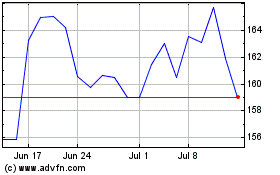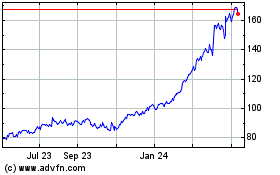By Matt Wirz
This article is being republished as part of our daily
reproduction of WSJ.com articles that also appeared in the U.S.
print edition of The Wall Street Journal (January 10, 2019).
General Electric Co. is battling to improve its credit rating,
bucking investor expectations that the company is headed for
junk-debt territory.
The Boston company has an investment-grade credit rating despite
a 54% decline in its share price over the past year and a 9% drop
in the price of its bonds.
If GE loses its investment-grade credit rating, its borrowing
costs will rise, increasing pressure on its ailing industrial and
lending businesses and threatening thousands of investors in its
stocks and bonds.
Management has said it plans to improve the company's finances
to reverse the rating downgrade in October to BBB-plus, three
notches above junk-debt territory.
Credit-ratings firms say planned restructuring and divestitures
should help GE avoid further downgrades, but investors are less
sanguine. Here are some factors that will determine whether GE can
avoid another ratings cut.
Losing Leverage
A key variable in GE's rating is its leverage ratio. In GE's
case, that is a measure of its liabilities, around $115 billion,
relative to the cash the company generates from its continuing
operations.
The ratio compares debt to earnings before interest, taxes,
depreciation and amortization, or Ebitda. The higher the ratio, the
greater the risk that GE may have trouble servicing its debt,
rolling it over when it comes due or repaying it.
Analysts estimated leverage for GE's core industrial business at
4 to 4.5 times in September, which already exceeds the norm for
investment-grade bond issuers. Average leverage for companies rated
BBB was 2.9 times in 2017, according to research by Pacific
Investment Management Co.
Moody's Investors Service has said it could downgrade GE if
leverage doesn't steadily drop toward less than three times;
S&P Global Ratings said it could downgrade if the ratio stays
above four times for two years.
Management's messaging on the issue has been mixed. GE Chief
Financial Officer Jamie Miller said in June that the company would
cut leverage to 2.5 times by 2020, mostly by divesting itself of
assets to reduce its liabilities. But she rattled investors on an
October conference call by apparently retreating from that target,
saying, "We expect to make substantial progress toward this goal in
the next few years."
"GE remains committed to strengthening the balance sheet
including deleveraging," a company spokeswoman said this week.
"Long term, we continue to target a credit rating in the single-A
range."
Equity Sale
JPMorgan Chase & Co. stock analyst Stephen Tusa, who
recommended selling GE stock in 2016 before it began the steepest
part of its descent, said asset sales and spinoffs won't be enough
for GE to hit its leverage target. The company will also likely
need to issue $25 billion of new stock to pay off liabilities, he
said in a December research report.
Mr. Tusa has set a $6 price target for the stock -- about 29%
below the current price of $8.50 -- but raised his recommendation
on GE to "neutral."
But a deal that size would be hard at the best of times and is
probably out of reach, given GE's depressed stock price and
investors' fear about a slowdown in the U.S. economy, analysts and
bankers said. The largest equity sale ever of a stock under $10 was
Citigroup's $17.6 billion deal in 2009, following the bank's
bailout during the financial crisis, according to data from
Dealogic.
GE CEO Larry Culp has said he has no plans to raise equity and
that divestitures will be sufficient to pare debt.
Deal Risk
GE spent much of 2018 shedding assets worth at least $18
billion, according to company statements. The largest deals are yet
to come: the expected sale of a 50.5% stake in Baker Hughes worth
about $12 billion and the planned spinoff of GE's health-care unit
into a new company, to which GE would transfer about $18 billion of
debt and pension liabilities.
But the stock-market havoc of recent months has chilled
mergers-and-acquisitions activity, and a selloff in oil has dragged
Baker Hughes shares down about 32% since September. If the U.S.
economy slows down, it will be even harder to close the large deals
as planned.
"I'd like to see a little bit of progress in getting those asset
sales done," said Lon Erickson, a portfolio manager at Thornburg
Investment Management, who is holding off on buying GE bonds in his
firm's $5 billion investment-grade bond fund. "Are they going to
get the valuations they think?"
GE could also auction off GE Capital's lucrative
aircraft-leasing business, an investment banker said. But that
would gut GE Capital's revenues, a major risk if the lending
division discloses more losses from its long-term insurance
portfolio.
The Other Shoe
Investors were shocked by GE's revelations last year of a $6.2
billion long-term care insurance charge and a $22 billion charge
from the power business. Now their biggest worry is that more
negative surprises are waiting in the wings.
Where could the bad news could come from? One area is more
insurance and power-related losses. Another is larger-than-expected
settlements and fines from lawsuits and federal investigations
involving GE's subprime-mortgage lending and accounting policies,
CreditSights analysts Kristina Regan and Jesse Rosenthal wrote in a
report.
While credit-rating firms are being patient with GE for now,
"More shoes dropping could cause the agencies to shorten up on that
leash," they said.
The deleveraging plan is susceptible to another hard-to-predict
variable: the movement of U.S. interest rates. When rates rise, the
company's pension fund makes more money on bond investments,
shrinking its deficit, and analysts predicted that climbing U.S.
Treasury yields would reduce the shortfall by about $9 billion in
2018. But rates have been falling in recent weeks amid concerns
about slowing economic growth, a swing that could inflate GE's
pension gap by billions of dollars.
Write to Matt Wirz at matthieu.wirz@wsj.com
(END) Dow Jones Newswires
January 10, 2019 02:47 ET (07:47 GMT)
Copyright (c) 2019 Dow Jones & Company, Inc.
GE Aerospace (NYSE:GE)
Historical Stock Chart
From Mar 2024 to Apr 2024

GE Aerospace (NYSE:GE)
Historical Stock Chart
From Apr 2023 to Apr 2024
